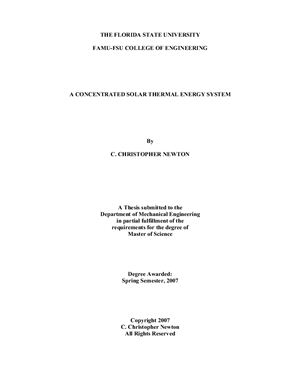A Thesis submitted to the Department of Mechanical Engineering in
partial fulfillment of the requirements for the degree of Master of
Science, 2007. - 164 pages.
Solar thermal technology is competitive in some very limited markets. The most common use for solar thermal technology has been for water heating in sunny climates. Another use is for power production, such as the Vanguard system and the Shannendoah Valley Parabolic dish system. However, due to the complex design and costs of production and maintenance, solar thermal systems have fallen behind in the world of alteative energy systems.
The concentrated solar thermal energy system constructed for this work follows that of
the conventional design of a parabolic concentrator with the receiver placed along the line
between the center of the concentrator and the sun. This allows for effective collecting and
concentrating of the incoming solar irradiation. The concentrator receives approximately 1.064
kW/m2 of solar insolation (dependent upon time of year), which is concentrated and reflected to
the receiver. By concentrating the incoming radiation, the operating temperature of the system is
increased significantly, and subsequently increases the efficiency of the conversion from sunlight
to electricity. For the current system, with a concentration ratio of 96, the concentrator is
theoretically capable of producing temperatures upwards to 712 degrees centigrade. However,
due to degradation of the optics and other various factors, temperatures as high as 560 degrees
centigrade have been achieved. It was found that the collector (concentrator + receiver) yields
an efficiency of 95.6 percent.
The system converts this concentrated solar energy to electric energy by use of a Rankine
cycle which is operated intermittently; determinant by operating temperature. The efficiency of
the Rankine cycle for this system was determined to be 3.2 percent, which is 10.3 percent of its
Caot Efficiency.
Solar thermal technology is competitive in some very limited markets. The most common use for solar thermal technology has been for water heating in sunny climates. Another use is for power production, such as the Vanguard system and the Shannendoah Valley Parabolic dish system. However, due to the complex design and costs of production and maintenance, solar thermal systems have fallen behind in the world of alteative energy systems.
The concentrated solar thermal energy system constructed for this work follows that of
the conventional design of a parabolic concentrator with the receiver placed along the line
between the center of the concentrator and the sun. This allows for effective collecting and
concentrating of the incoming solar irradiation. The concentrator receives approximately 1.064
kW/m2 of solar insolation (dependent upon time of year), which is concentrated and reflected to
the receiver. By concentrating the incoming radiation, the operating temperature of the system is
increased significantly, and subsequently increases the efficiency of the conversion from sunlight
to electricity. For the current system, with a concentration ratio of 96, the concentrator is
theoretically capable of producing temperatures upwards to 712 degrees centigrade. However,
due to degradation of the optics and other various factors, temperatures as high as 560 degrees
centigrade have been achieved. It was found that the collector (concentrator + receiver) yields
an efficiency of 95.6 percent.
The system converts this concentrated solar energy to electric energy by use of a Rankine
cycle which is operated intermittently; determinant by operating temperature. The efficiency of
the Rankine cycle for this system was determined to be 3.2 percent, which is 10.3 percent of its
Caot Efficiency.

